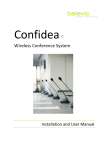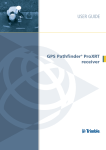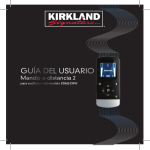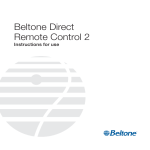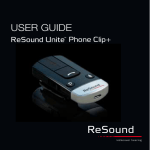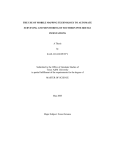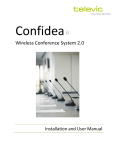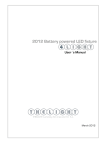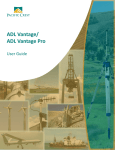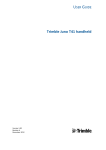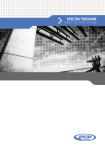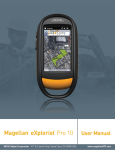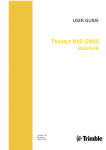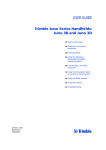Download Trimble R1 GNSS Receiver User Guide
Transcript
USER GUIDE Trimble R1 GNSS Receiver Version 1.00 Revision B June 2015 1 Corporate Office Trimble Navigation Limited 10368 Westmoor Drive Westminster, CO 80021 USA www.trimble.com Legal Notices © 2015, Trimble Navigation Limited. All rights reserved. Trimble, the Globe & Triangle logo, GPS Pathfinder, and Juno are trademarks of Trimble Navigation Limited, registered in the United States and in other countries. Positions, TerraFlex, TerraSync, and ViewPoint are trademarks of Trimble Navigation Limited. Microsoft, and Windows are either registered trademarks or trademarks of Microsoft Corporation in the United States and/or other countries. iPad, iPhone, and Retina are trademarks of Apple Inc., registered in the U.S. and other countries. iPad Air, iPad Air 2, and iPad mini are trademarks of Apple Inc. The Bluetooth word mark and logos are owned by the Bluetooth SIG, Inc. and any use of such marks by Trimble Navigation Limited is under license. All other trademarks are the property of their respective owners. Support for Galileo is developed under a license of the European Union and the European Space Agency. Made for - iPhone 6 Plus, iPhone 6 - iPhone 5s, iPhone 5c, iPhone 5 - iPad Air, iPad Air 2 - iPad mini with Retina display - iPad (4th generation) - iPad mini “Made for iPhone,” and “Made for iPad” mean that an electronic accessory has been designed to connect specifically to iPhone or iPad, respectively, and has been certified by the developer to meet Apple performance standards. Apple is not responsible for the operation of this device or its compliance with safety and regulatory standards. Please note that the use of this accessory with iPhone or iPad may affect wireless performance. Limited Warranty Terms and Conditions Product Limited Warranty Subject to the terms and conditions set forth herein, Trimble Navigation Limited (“Trimble”) warrants that for a period of 2 years from date of purchase this Trimble product (the “Product”) will substantially conform to Trimble's publicly available specifications for the Product and that the hardware and any storage media components of the Product will be substantially free from defects in materials and workmanship. Product Software Product software, whether built into hardware circuitry as firmware, provided as a standalone computer software product, embedded in flash memory, or stored on magnetic or other media, is licensed solely for use with or as an integral part of the Product and is not sold. The terms of the end user license agreement, as included below, govern the use of the Product Software, including any differing limited warranty terms, exclusions and limitations, which shall control over the terms and conditions set forth in the limited Product warranty. Warranty Remedies If the Trimble Product fails during the warranty period for reasons covered by this limited warranty and you notify Trimble of such failure during the warranty period, Trimble will repair OR replace the nonconforming Product with new, equivalent to new, or reconditioned parts or Product, OR refund the Product purchase price paid by you, at Trimble’s option, upon your return of the Product in accordance with Trimble's product return procedures then in effect. How to Obtain Warranty Service To obtain warranty service for the Product, please contact your Trimble dealer. Alternatively, you may contact Trimble to request warranty service at +1-408-481-6940 (24 hours a day) or email your request to [email protected]. Please be prepared to provide: –your name, address, and telephone numbers; –proof of purchase; –a copy of this Trimble warranty 2 Trimble R1 GNSS Receiver User Guide –a description of the nonconforming Product including the model number; and –an explanation of the problem. The customer service representative may need additional information from you depending on the nature of the problem. Warranty Exclusions and Disclaimer This Product limited warranty shall only apply in the event and to the extent that (i) the Product is properly and correctly installed, configured, interfaced, maintained, stored, and operated in accordance with Trimble's applicable operator's manual and specifications, and; (ii) the Product is not modified or misused. This Product limited warranty shall not apply to, and Trimble shall not be responsible for, defects or performance problems resulting from (i) the combination or utilization of the Product with hardware or software products, information, data, systems, interfaces, or devices not made, supplied, or specified by Trimble; (ii) the operation of the Product under any specification other than, or in addition to, Trimble's standard specifications for its products; (iii) the unauthorized installation, modification, or use of the Product; (iv) damage caused by: accident, lightning or other electrical discharge, fresh or salt water immersion or spray (outside of Product specifications); or exposure to environmental conditions for which the Product is not intended; (v) normal wear and tear on consumable parts (e.g., batteries); or (vi) cosmetic damage. Trimble does not warrant or guarantee the results obtained through the use of the Product or Software, or that software components will operate error free. NOTICE REGARDING PRODUCTS EQUIPPED WITH TECHNOLOGY CAPABLE OF TRACKING SATELLITE SIGNALS FROM SATELLITE BASED AUGMENTATION SYSTEMS (SBAS) (WAAS, EGNOS, AND MSAS), OMNISTAR, GPS, MODERNIZED GPS OR GLONASS SATELLITES, OR FROM IALA BEACON SOURCES: TRIMBLE IS NOT RESPONSIBLE FOR THE OPERATION OR FAILURE OF OPERATION OF ANY SATELLITE BASED POSITIONING SYSTEM OR THE AVAILABILITY OF ANY SATELLITE BASED POSITIONING SIGNALS. THE FOREGOING LIMITED WARRANTY TERMS STATE TRIMBLE’S ENTIRE LIABILITY, AND YOUR EXCLUSIVE REMEDIES, RELATING TO THE TRIMBLE PRODUCT. EXCEPT AS OTHERWISE EXPRESSLY PROVIDED HEREIN, THE PRODUCT, AND ACCOMPANYING DOCUMENTATION AND MATERIALS ARE PROVIDED “AS-IS” AND WITHOUT EXPRESS OR IMPLIED WARRANTY OF ANY KIND, BY EITHER TRIMBLE OR ANYONE WHO HAS BEEN INVOLVED IN ITS CREATION, PRODUCTION, INSTALLATION, OR DISTRIBUTION, INCLUDING, BUT NOT LIMITED TO, THE IMPLIED WARRANTIES OF MERCHANTABILITY AND FITNESS FOR A PARTICULAR PURPOSE, TITLE, AND NONINFRINGEMENT. THE STATED EXPRESS WARRANTIES ARE IN LIEU OF ALL OBLIGATIONS OR LIABILITIES ON THE PART OF TRIMBLE ARISING OUT OF, OR IN CONNECTION WITH, ANY PRODUCT. BECAUSE SOME STATES AND JURISDICTIONS DO NOT ALLOW LIMITATIONS ON DURATION OR THE EXCLUSION OF AN IMPLIED WARRANTY, THE ABOVE LIMITATION MAY NOT APPLY TO YOU. Limitation of Liability TRIMBLE'S ENTIRE LIABILITY UNDER ANY PROVISION HEREIN SHALL BE LIMITED TO THE AMOUNT PAID BY YOU FOR THE PRODUCT. TO THE MAXIMUM EXTENT PERMITTED BY APPLICABLE LAW, IN NO EVENT SHALL TRIMBLE OR ITS SUPPLIERS BE LIABLE FOR ANY INDIRECT, SPECIAL, INCIDENTAL, OR CONSEQUENTIAL DAMAGE WHATSOEVER UNDER ANY CIRCUMSTANCE OR LEGAL THEORY RELATING IN ANYWAY TO THE PRODUCTS, SOFTWARE AND ACCOMPANYING DOCUMENTATION AND MATERIALS, (INCLUDING, WITHOUT LIMITATION, DAMAGES FOR LOSS OF BUSINESS PROFITS, BUSINESS INTERRUPTION, LOSS OF DATA, OR ANY OTHER PECUNIARY LOSS), REGARDLESS OF WHETHER TRIMBLE HAS BEEN ADVISED OF THE POSSIBILITY OF ANY SUCH LOSS AND REGARDLESS OF THE COURSE OF DEALING WHICH DEVELOPS OR HAS DEVELOPED BETWEEN YOU AND TRIMBLE. BECAUSE SOME STATES AND JURISDICTIONS DO NOT ALLOW THE EXCLUSION OR LIMITATION OF LIABILITY FOR CONSEQUENTIAL OR INCIDENTAL DAMAGES, THE ABOVE LIMITATION MAY NOT APPLY TO YOU. PLEASE NOTE: THE ABOVE TRIMBLE LIMITED WARRANTY PROVISIONS WILL NOT APPLY TO PRODUCTS PURCHASED IN THOSE JURISDICTIONS (E.G., MEMBER STATES OF THE EUROPEAN ECONOMIC AREA) IN WHICH PRODUCT WARRANTIES ARE THE RESPONSIBILITY OF THE LOCAL DEALER FROM WHOM THE PRODUCTS ARE ACQUIRED. IN SUCH A CASE, PLEASE CONTACT YOUR TRIMBLE DEALER FOR APPLICABLE WARRANTY INFORMATION. Notice to Australian Purchasers The Australian Consumer Law Our goods come with guarantees that cannot be excluded under the Australian Consumer Law. You are entitled to a replacement or refund for a major failure and for compensation for any other reasonably foreseeable loss or damage. You are also entitled to have the goods repaired or replaced if the goods fail to be of acceptable quality and the failure does not amount to a major failure. Trimble's warranty, as set out in the user manual accompanying this statement, or as described in the warranty card accompanying the Product you purchased, is in addition to any mandatory rights and remedies that you may have under the Australian Consumer Law. Official Language THE OFFICIAL LANGUAGE OF THESE TERMS AND CONDITIONS IS ENGLISH. IN THE EVENT OF A CONFLICT BETWEEN ENGLISH AND OTHER LANGUAGE VERSIONS, THE ENGLISH LANGUAGE SHALL CONTROL. Notices COCOM limits The U.S. Department of Commerce requires that all exportable GPS products contain performance limitations so that they cannot be used in a manner that could threaten the security of the United States. The following limitations are implemented on this product: – Immediate access to satellite measurements and navigation results is disabled when the receiver velocity is computed to be greater than 1,000 knots, or its altitude is computed to be above 18,000 meters. The receiver GPS subsystem resets until the COCOM situation clears. As a result, all logging and stream configurations stop until the GPS subsystem is cleared. Class B statement- Notice to users This equipment has been tested and found to comply with the limits for a Class B digital device pursuant to Part 15 of the FCC Rules. Operation is subject to the following two conditions: (1) this device may not cause harmful interference, and (2) this device must accept any interference received, including interference that may cause undesired operation. This equipment generates, uses, and can radiate radio frequency energy and, if not installed and used in accordance with the instructions may cause harmful interference to radio communication. However, there is no guarantee that interference will not occur in a particular installation. If this equipment does cause harmful interference to radio or television reception, which can be determined by turning the equipment off and on, the user is encouraged to try to correct the interference by one or more of the following measures: –Reorient or relocate the receiving antenna. –Increase the separation between the equipment and the receiver. –Connect the equipment into an outlet on a circuit different from that to which the receiver is connected. –Consult the dealer or an experienced radio/TV technician for help. Changes and modifications not expressly approved by the manufacturer or registrant of this equipment can void your authority to operate this equipment under Federal Communications Commission rules. The radios in this device have been designed and manufactured to not exceed stipulated emission limits for exposure to radio frequency (RF) energy as required by the Federal Communications Commission of the U.S. Government 47 C.F.R. § 2.1091 and 2.1093. The external antenna connector provided in this device is for GNSS antennas only. so chosen that the equivalent isotropically radiated power (e.i.r.p.) is not more than that necessary for successful communication. Conformément à la réglementation d'Industrie Canada, le présent émetteur radio peut fonctionner avec une antenne d'un type et d'un gain maximal (ou inférieur) approuvé pour l'émetteur par Industrie Canada. Dans le but de réduire les risques de brouillage radioélectrique à l'intention des autres utilisateurs, il faut choisir le type d'antenne et son gain de sorte que la puissance isotrope rayonnée équivalente (p.i.r.e.) ne dépasse pas l'intensité nécessaire à l'établissement d'une communication satisfaisante. Licence exempt This device complies with Industry Canada licence-exempt RSS standard (s). Operation is subject to the following two conditions: (1) this device may not cause interference, and (2) this device must accept any interference, including interference that may cause undesired operation of the device. Le présent appareil est conforme aux CNR d'Industrie Canada applicables aux appareils radio exempts de licence. L'exploitation est autorisée aux deux conditions suivantes : (1) l'appareil ne doit pas produire de brouillage, et (2) l'utilisateur de l'appareil doit accepter tout brouillage radioélectrique subi, même si le brouillage est susceptible d'en compromettre le fonctionnement. Europe This product has been tested and found to comply with all requirements for CE Marking and sale within the European Economic Area (EEA). It is classified and marked as being Class 2 Radio Equipment under 2000/299/EC, as Bluetooth and wireless LAN approvals are country specific. Please consult your local distributor for more information. EU – Restrictions for Use in the 2.4GHz band This device may be operated indoors or outdoors in all countries of the European Community using the 2.4GHz band, except where noted below. –In Norway, this unit may not be operated within 20 km of Ny Alesund This GNSS receiver has Bluetooth approval in most EU countries and satisfies the requirements for Radio and Telecommunication Terminal Equipment specified by European Council Directive 1999/5/EC. These requirements provide reasonable protection against harmful interference when the equipment is operated appropriately in a residential or commercial environment. A copy of the CE Declaration of Conformity can be accessed from http://www.trimble.com/support.shtml. Australia and New Zealand This product conforms with the regulatory requirements of the Australian Communications and Media Authority (ACMA) EMC framework, thus satisfying the requirements for C-Tick Marking and sale within Australia and New Zealand. Japan This device has been granted two designation numbers by Ministry of Internal Affairs and Communications: according: Ordinance concerning Technical Regulations Conformity Certification etc. of Specified Radio Equipment (特定無線設備の技術基準適合証明 等に関する規則) Article 2 clause 1 item 19 Approval no: 007-AC0223 This device should not be modified (otherwise the granted designation numbers will be invalid). Canada Restriction of Use of Certain Hazardous Substances in Electrical This digital apparatus does not exceed the Class B limits for radio noise emissions from digital apparatus as set out in the radio interference regulations of the Canadian Department of Communications. Le présent appareil numérique n'émet pas de bruits radioélectriques dépassant les limites applicables aux appareils numériques de Classe B prescrites dans le règlement sur le brouillage radioélectrique édicté par le Ministère des Communications du Canada. Antenna Statement Under Industry Canada regulations, this radio transmitter may only operate using an antenna of a type and maximum (or lesser) gain approved for the transmitter by Industry Canada. To reduce potential radio interference to other users, the antenna type and its gain should be and Electronic Equipment (RoHS) Trimble products in this guide are in compliance in all material respects with DIRECTIVE 2011/65/EU OF THE EUROPEAN PARLIAMENT AND OF THE COUNCIL of 8 June 2011 on the restriction of the use of certain hazardous substances in electrical and electronic equipment (recast). This certification is limited to Product placed on the market in the Member States of the European Union on or after 1-January-2013. Trimble R1 GNSS Receiver User Guide 3 Waste Electrical and Electronic Equipment (WEEE) For product recycling instructions and more information, please go to www.trimble.com/ev.shtml. Recycling in Europe: To recycle Trimble WEEE (Waste Electrical and Electronic Equipment, products that run on electrical power.), Call +31 497 53 24 30, and ask for the “WEEE Associate”. Or, mail a request for recycling instructions to: Trimble Europe BV c/o Menlo Worldwide Logistics Meerheide 45 5521 DZ Eersel, NL FCC Declaration of Conformity We, Trimble Navigation Limited. 935 Stewart Drive PO Box 3642 Sunnyvale, CA 94088-3642 United States +1-408-481-8000 Declare under sole responsibility that DoC products comply with Part 15 of FCC Rules. Operation is subject to the following two conditions: (1) This device may not cause harmful interference, and (2) This device must accept any interference received, including interference that may cause undesired operation. Unlicensed radios in products This device complies with part 15 of the FCC Rules. Operation is subject to the following two conditions: (1) This device may not cause harmful interference, and (2) This device must accept any interference received, including interference that may cause undesired operation. Licensed radios in products This device complies with part 15 of the FCC Rules. Operation is subject to the condition that this device may not cause harmful interference. Release Notice This is the June 2015 release (Revision B) of the R1 GNSS receiver User Guide. 4 Trimble R1 GNSS Receiver User Guide Safety Information Safety Information Before you use your Trimble product, make sure that you have read and understood all safety requirements. WARNING – This alert warns of a potential hazard which, if not avoided, could result in severe injury or even death. CAUTION – This alert warns of a potential hazard or unsafe practice that could result in minor injury or property damage or irretrievable data loss. Note – An absence of specific alerts does not mean that there are no safety risks involved. Use and care This product is is a high-precision electronic instrument and should be treated with reasonable care. CAUTION – Operating or storing the receiver outside the specified temperature range can damage it. Using an external antenna WARNING – Antennas are excellent conductors of electricity, so use extreme caution when operating near power lines and other sources of electric current or during stormy weather. Exposure to radio frequency radiation from Bluetooth transmitters This device is approved as a portable device with respect to Radio Frequency (RF) exposure compliance. The radiated output power of the internal wireless radio transmitters is less than 100 milliwatt, which results in exposure levels far below the FCC radio frequency exposure limits, even when operated in close proximity to the body. The internal wireless radios operate within guidelines found in international radio frequency safety standards and recommendations, which reflect the consensus of the international scientific community. Trimble therefore believes the internal wireless radios are safe for use by users. The level of electromagnetic energy emitted is hundreds of times lower than the electromagnetic energy emitted by wireless devices such as mobile phones. However, the use of wireless radios may be restricted in some situations or environments, such as on aircraft. If you are unsure of restrictions, you are encouraged to ask for authorization before turning on the wireless radios. Trimble R1 GNSS Receiver User Guide 5 Contents Safety Information 5 Use and care Using an external antenna Exposure to radio frequency radiation from Bluetooth transmitters 1 Introduction 5 5 5 7 What is the R1 GNSS receiver What's in the box Accessories Supported software Related information and technical support 8 9 9 9 9 2 Using the R1 GNSS receiver 11 Parts of the receiver Charging the battery Turning on and turning off the receiver LED status information Connecting the R1 GNSS receiver to a device Using the R1 GNSS receiver with GIS software on Windows Embedded Handheld and Windows devices Using the GNSS Status utility Using an external antenna 3 Troubleshooting 12 12 13 14 15 16 16 18 19 Receiver won't turn on Battery indicator for R1 GNSS receiver shows empty on an iOS device R1 GNSS receiver firmware upgrade Incorrect R1 GNSS receiver name showing in Bluetooth settings on iOS device Glossary 20 20 20 21 22 Trimble R1 GNSS Receiver User Guide 6 CHAPTER 1 Introduction In this chapter: n What is the R1 GNSS receiver n What's in the box n Accessories n Supported software n Related information and technical support The Trimble R1 GNSS Receiver User Guide describes how to use a Trimble® R1 GNSS receiver. Even if you have used other GNSS or GPS products before, Trimble recommends that you spend some time reading this manual to learn about the special features of this product. If you are not familiar with GNSS or GPS, visit the Trimble website (www.trimble.com). Trimble R1 GNSS Receiver User Guide 7 1 Introduction What is the R1 GNSS receiver The R1 GNSS receiver is a high-performance GNSS receiver with an integrated antenna, and Bluetooth® wireless technology for connectivity with field computers and smart phones. It is rated IP65, and is small enough to be carried in a pocket or worn on a belt clip in its pouch. The R1 GNSS receiver achieves best real time performance when used with a real-time correction source, such as SBAS, over L-Band (Trimble RTX™ technology), or IP via a phone device (Trimble VRS™ or RTX technology). Supported devices The R1 GNSS receiver is compatible with devices powered by the following operating systems: l l Android versions 4.1x and later iOS l l Windows® 7 and Windows 8.x Windows Embedded Handheld 6.5 Supported constellations The R1 GNSS receiver supports the following L1 constellations: l l l GPS L1 C/A GLONASS L1 C/A (G1) Galileo E1 l l BeiDou B1 QZSS L1 C/A Supported correction sources The R1 GNSS receiver supports the following correction signals: l SBAS (WAAAS / EGNOS / MSAS / GAGAN, SDCM) CMR, CMR+, CMRx l RTCM 2.0 to 2.3 (DGPS and RTK), RTCM 3.0 and 3.1 l l l QZSS L1 SAIF RTX ViewPoint™ (via Internet and L-Band satellite) CAUTION – SBAS and L-Band signals are highly compromised when the receiver is used close to the body; geostationary satellites will have a lower signal margin at the receiver than the typical orbiting GNSS satellites. Performance will heavily depend on factors such as user orientation, position of the receiver on body, how exposed the antenna is, and geographic location. Trimble R1 GNSS Receiver User Guide 8 1 Introduction What's in the box l R1 GNSS receiver l USB cable l International adaptor kit l Belt pouch / clip l Quick Start Guide Accessories The following accessories are available for purchase to use with the R1 GNSS receiver: l Belt pouch / clip l Pole pouch l External antenna Supported software You can use the following Trimble software with the R1 GNSS receiver: l TerraFlex™ mobile software l TerraSync™ software l Positions™ ArcPad extension l GPS Pathfinder® Field toolkit If you are not using Trimble field software, use the Trimble GNSS Status utility to manage the connection to the R1 GNSS receiver. See Using the GNSS Status utility, page 16. For full details of compatility with Trimble software, refer to the Product Compatibilty List. For information on using the receiver with Trimble field software, refer to the documention for the software you are using. Related information and technical support Product updates, documentation, and any support issues are available for download on the Support area of the Trimble website (www.trimble.com/Support/). Sources of related information include the following: l Release notes – The release notes describe new features of the product, information not included in the manuals, and any changes to the manuals. Trimble R1 GNSS Receiver User Guide 9 1 Introduction l Support notes – Support notes describe any known issues and offer solutions or workarounds that may be required throughout the life of the product. These documents can be downloaded from the Trimble website at www.trimble.com/Support/Support_AZ.aspx. Select the product you need information on. If you have a problem and cannot find the information you need in the product documentation, contact your local dealer. Trimble R1 GNSS Receiver User Guide 10 CHAPTER 2 Using the R1 GNSS receiver In this chapter: n Parts of the receiver n Charging the battery n Turning on and turning off the receiver n LED status information n Connecting the R1 GNSS receiver to a device n Using the GNSS Status utility n Using an external antenna Trimble R1 GNSS Receiver User Guide 11 2 Using the R1 GNSS receiver Parts of the receiver ❶ External antenna connector ❷ LED: Bluetooth and GNSS ❸ Power LED ❹ Power button / Bluetooth pairing button ❺ Mini USB / charger connection (rear of device) Charging the battery WARNING – Charge and use the rechargeable Lithium-ion battery only in strict accordance with the instructions. To prevent injury or damage: – Discontinue charging a battery that gives off extreme heat or a burning odor. – Never attempt to remove, replace, or repair the battery yourself. – If the battery requires attention, send the receiver to an authorized Trimble Service Center. Before using a new R1 GNSS receiver, or one which has been unused for months, charge the device with the supplied charger until the Power LED is solid green . To charge the internal battery, do one of the following: l l Connect the R1 GNSS receiver to your laptop or office computer using the USB cable supplied with the product. Connect the R1 GNSS receiver to mains power using the USB cable and internation adaptor kit supplied with the product. Charging the receiver's battery using the Trimble-supplied charger connected to mains power can take up to 5 hours. Charging from a laptop or desktop computer or using an unapproved charger can take longer. Trimble R1 GNSS Receiver User Guide 12 2 Using the R1 GNSS receiver When the battery is charging, the Power LED shows solid amber . When the battery is fully charged, and the charger is still connected, the green . LED changes to solid Note – If the battery is severely discharged, for example if the receiver is new and not yet charged, or it has been stored for more than a few months, the Power LED will not turn on until the battery has charged for a while. In this case, charge the battery for an hour using the supplied charger then disconnect and reconnect the USB cable. The Power LED should turn on. See LED status information, page 14 for more information on the status of the LEDs. Turning on and turning off the receiver To turn on the R1 GNSS receiver: 1. Press and hold the Power button until both LEDs = 2. After a few seconds, the (green), then release the Power button. LED flashes - - - - - - - - - (blue / amber). To pair the receiver with your device using Bluetooth wireless technology, see Connecting the R1 GNSS receiver to a device, page 15. To turn off the R1 GNSS receiver: 1. Press and hold the Power button until both LEDs are 2. Continue holding the Power button until the release the Power button. (red). LED turns off ( the stays red ), then 3. Both LEDs will turn off. Note – If the receiver is connected to external power via USB, the or LED turns on (green) (amber) almost immediately, depending on the level of charge. For a description of the LED behavior, see LED status information, page 14. Trimble R1 GNSS Receiver User Guide 13 2 Using the R1 GNSS receiver LED status information Power LED LED Status Off ------ ------ ------ ------ ------ ------ - - - Solid amber Battery is charging, charge is < 100%. Solid green Battery is fully charged (Charger is connected). Battery charge is >50% (Charger is not connected). Slow flashing Battery charge is >15% (Charger is not amber connected). Slow flashing red Battery charge is <15% (Charger is not connected). The battery needs charging. Rapid flashing red Battery / power error. Note – If the battery is severely discharged, for example if the receiver is new and not yet charged, or it has been stored for more than a few months, the Power LED will not turn on until the battery has charged for a while. In this case, charge the battery for an hour using the supplied charger then disconnect and reconnect the USB cable. The Power LED should turn on. Bluetooth / GNSS LED LED - Bluetooth status - - --- --- --- --- --- --- --- --- --- ------ ------ ------ GNSS status Rapid flashing blue Receiver is in Bluetooth pairing mode (see Connecting the R1 GNSS receiver to a device, page 15. Flashing blue / Not connected. amber Flashing blue / Not connected. green Flashing amber Connected. Not connected. Slow flashing green Connected. Connected, sending autonomous positions. Connected, sending corrected positions. Solid green Connected. Not connected. Connected. Not connected. Trimble R1 GNSS Receiver User Guide 14 2 Using the R1 GNSS receiver Connecting the R1 GNSS receiver to a device You can connect a R1 GNSS receiver to a handheld device or tablet powered by the following operating systems: l Android versions 4.1x and later l iOS l Windows® 7 and Windows 8.x l Windows Embedded Handheld 6.5 Enabling Mock Locations on Android devices On Android devices, you must enable Mock Locations to allow the Android device to use GNSS positions from the R1 GNSS receiver. The method for enabling Mock Locations differs for different Android devices. Generally, this is done under Settings / Developer options, Allow mock locations. Refer to the documentation for your device for specific instructions. Pairing a R1 GNSS receiver and a device The first time you use a R1 GNSS receiver, you must pair it with your device. 1. Make sure the device you want to use has Bluetooth wireless techology turned on. 2. To place the R1 GNSS receiver in Bluetooth pairing mode, press and hold the Power button until the LED flashes blue . 3. Depending on the device you want to pair the receiver with, do one of the following: l On a device powered by the Windows 7 or 8.x operating system, Windows Embedded Handheld 6.5, or Android versions 4.1.x or later, use the GNSS Status utility to pair with the receiver. a. Tap GNSS Status to launch the GNSS Status utility. b. Tap Select new receiver. The device you are using searches for receivers within range. c. When the required receiver appears in the Select Receiver list, tap it, then tap the connection icon to the right of the receiver ID to pair. l On an iPhone or iPad, go to Settings / Bluetooth, and tap the R1 [ID] device you want to pair with. Connecting to a R1 GNSS receiver To reconnect to a receiver at any time, make sure it is turned on, then: Trimble R1 GNSS Receiver User Guide 15 2 Using the R1 GNSS receiver l On a device powered by the Windows 7 or 8.x operating system, Windows Embedded Handheld 6.5, or Android versions 4.1.x or later, use the GNSS Status utility to connect with the receiver: a. Tap GNSS Status to launch the GNSS Status utility. b. Tap the R1 [ID] at the bottom of the screen to bring up the Select Receiver list. Tap the device [R1 ID] you want to reconnect to. Tap the connection icon to the right of the receiver ID to connect to it. l On an iPhone or iPad, go to Settings / Bluetooth, and tap the R1 [ID] device you want to connect to. See Using the GNSS Status utility, page 16 for more information. Using the R1 GNSS receiver with GIS software on Windows Embedded Handheld and Windows devices If you are using Trimble GIS software (for example, TerraSync software, Trimble Positions software, or the GPS Pathfinder Field toolkit) on devices powered by the Windows Embedded Handheld or Windows Desktop operating systems, you do not need to install the GNSS Status utility, unless you want to install an option (subscription service) that you have purchased (see Receiver options, page 17). You can connect to the R1 GNSS receiver from within the software when the receiver is in Bluetooth pairing mode, as with other Trimble GIS external receivers. Using the GNSS Status utility Download the GNSS Status utility for your device: l for Windows, Windows Embedded Handheld, go to the product downloads page on www.trimble.com l for Android, go to Google Play store and search for “GNSS Status Utility" l for iOS, go to iTunes app store and search for "GNSS Status Utility" On your device, tap GNSS Status to launch the GNSS Status utility. If the device you are using is not connected to a R1 GNSS receiver, the GNSS Status utility shows: l Select new receiver enabling you to select a R1 GNSS receiver to connect to If the device you are using is connected to a R1 GNSS receiver, the GNSS Status utility Home screen shows: Trimble R1 GNSS Receiver User Guide 16 2 Using the R1 GNSS receiver l The estimated GNSS accuracy l The R1 GNSS receiver's battery status l The DGNSS status l The menu (on tablets), or Menu icon l The ID of the connected R1 GNSS receiver (on smartphones and handheld devices) The menu options are described below. Detailed status Tap the Estimated Accuracy shown on the Home screen. Or, flick the current screen to the right to display the menu options, or tap , then tap Detailed Status. The Detailed Status screen shows: l l the receiver's GNSS status the satellites that are in use and being tracked (for all supported constellations; see Supported constellations, page 8) l the real-time correction source in use l the receiver's serial number, firmware version, and battery charge status l packets received (if you are using Internet based sources) and error messages App settings You can configure the GNSS Status utility to use metric or imperial (US) units. 1. Tap or flick the current screen to the right to display the menu options. 2. Tap App Settings. On an iOS or Android device, tap Unit System. 3. Select Metric or US. Receiver options You can configure the R1 GNSS receiver to use options (subscription services) if you have purchased them. 1. Tap or flick the current screen to the right to display the menu options. 2. Tap Receiver Options. 3. In the Install Option field, enter the key you received when you purchased the option. 4. Tap Submit. Trimble R1 GNSS Receiver User Guide 17 2 Using the R1 GNSS receiver The Subscription Status is shown on the lower part of the screen. For more information on purchasing receiver options, contact your local Trimble reseller. Real-time config To configure real-time correction sources: 1. If a receiver is connected, tap the DGNSS Status shown on the Home screen. Or, flick the current screen to the right to display the menu options, or tap , then tap Real-time Config. 2. Tap Edit. On an iOS or Android device, tap Primary Source Type. 3. Select Internet, SBAS, or Uncorrected as the primary real-time correction source. 4. If you selected Internet as the primary source, tap the fields on the Real-time Config screen to configure the primary source, and set a Secondary Source Type (SBAS or Uncorrected). 5. Tap Apply. About The About screen shows the GNSS Status utility version number. Using an external antenna WARNING – Antennas are excellent conductors of electricity, so use extreme caution when operating near power lines and other sources of electric current or during stormy weather. Only use an external antenna that is designed to be used with the R1 GNSS receiver. To connect an external antenna, open the external antenna cover on the left side of the receiver and connect your antenna cable. Trimble R1 GNSS Receiver User Guide 18 CHAPTER 3 Troubleshooting In this chapter: n Receiver won't turn on n Battery indicator for R1 GNSS receiver shows empty on an iOS device n R1 GNSS receiver firmware upgrade n Incorrect R1 GNSS receiver name showing in Bluetooth settings on iOS device This section describes some possible receiver issues, possible causes, and how to solve them. Please read this section before you contact Technical Support. Trimble R1 GNSS Receiver User Guide 19 3 Troubleshooting Receiver won't turn on The R1 GNSS receiver will not turn on. There is no LED indication when the Power button is pressed. Cause: The battery is severely discharged. This may be because the device is new and has not yet been charged, or it has been in storage for more than a few months. Solution: Charge the battery for an hour using the supplied charger, then disconnect and reconnect the USB cable. The Power LED charge until the Power LED = should turn on. Leave the device on (Green). See Charging the battery, page 12. Battery indicator for R1 GNSS receiver shows empty on an iOS device On an iOS device, the small battery level indicator at the top of the status bar shows empty in error. Cause: This is an iOS issue which has been logged with Apple. Solution: Use the GNSS Status utility to view the battery status. See Using the GNSS Status utility, page 16. R1 GNSS receiver firmware upgrade When you upgrade the firmware on a R1 GNSS receiver, and it was previously paired with an iOS device, you cannot reconnect. Cause: The iOS device no longer recognises the R1 GNSS receiver when the firmware is upgraded on the receiver. Solution: Before you can reconnect your iOS device with a previously connected R1 GNSS receiver, you must 'forget' the connection on the iOS device: 1. Go to Settings / Bluetooth, and tap the Info button number] device you want to forget. next to the R1 [serial 2. Tap Forget this device. Trimble R1 GNSS Receiver User Guide 20 3 Troubleshooting You can then reconnect as usual (see Connecting the R1 GNSS receiver to a device, page 15) . Incorrect R1 GNSS receiver name showing in Bluetooth settings on iOS device When you restart an iOS device that has been connected to a R1 GNSS receiver, the receiver appears in the list under Bluetooth Settings as ‘iAP2’. This does not affect operation of the R1 GNSS receiver. Solution: To make the name of the R1 GNSS receiver reappear: 1. On the iOS device, go to Settings / Bluetooth, and connect to the ‘iAP2’ device. 2. While the Bluetooth settings screen is open on the iOS device, place the R1 GNSS receiver into Bluetooth pairing mode (press and hold the Power button until the LED flashes blue ). 3. After a short time the R1 GNSS receiver's name will reappear. Trimble R1 GNSS Receiver User Guide 21 Glossary Glossary BeiDou The BeiDou Navigation System (Compass) Navigation Satellite System is a Chinese satellite navigation system. The first BeiDou system (known as BeiDou-1), consists of three satellites and has limited coverage and applications. It has been offering navigation services mainly for customers in China and from neighboring regions since 2000. carrier carrier frequency carrier phase CMR/CMR+ CMRx DGNSS differential GNSS EGNOS firmware GAGAN Galileo GLONASS GNSS GPS L1 MSAS QZSS The second generation of the system (known as Compass or BeiDou-2) consists of 35 satellites. It became operational with coverage of China in December 2011 with 10 satellites in use. Services were planned to be offered to customers in Asia-Pacific region by 2012 and the global system should be finished by 2020. A radio wave having at least one characteristic (such as frequency, amplitude, or phase) that can be varied from a known reference value by modulation. The frequency of the unmodulated fundamental output of a radio transmitter. The GPS L1 carrier frequency is 1575.42 MHz. Is the cumulative phase count of the GPS or GLONASS carrier signal at a given time. Compact Measurement Record. A real-time message format developed by Trimble for broadcasting corrections to other Trimble receivers. CMR is a more efficient alternative to RTCM. A real-time message format developed by Trimble for transmitting more satellite corrections resulting from more satellite signals, more constellations, and more satellites. Its compactness means more repeaters can be used on a site. See real-time differential GNSS. See real-time differential GNSS. European Geostationary Navigation Overlay Service. A Satellite-Based Augmentation System (SBAS) that provides a free-to-air differential correction service for GNSS. EGNOS is the European equivalent of WAAS, which is available in the United States. The program inside the receiver that controls receiver operations and hardware. GPS Aided Geo Augmented Navigation. A regional SBAS system currently in development by the Indian government. Galileo is a GNSS system built by the European Union and the European Space Agency. It is complimentary to GPS and GLONASS. Global Orbiting Navigation Satellite System. Ccomparable to the American GPS system, GLONASS is a space-based navigation system operated by the Russian Aerospace Defence Forces, consisting of 24 satellites in 3 orbit planes. Global Navigation Satellite System. Global Positioning System. GPS is a space-based satellite navigation system consisting of multiple satellites in six orbit planes. The primary L-band carrier used by GPS and GLONASS satellites to transmit satellite data. Multi-functional Satellite Augmentation System. A Satellite-Based Augmentation System (SBAS) that provides a free-to-air differential correction service for GNSS. MSAS is the Japanese equivalent of WAAS. Quasi-Zenith Satellite System. A Japanese regional time transfer and Satellite Based Trimble R1 GNSS Receiver User Guide 22 Glossary Augmentation System (SBAS) for the GNSS, consisting of three geosynchronous satellites over Japan. real-time differential Also known as real-time differential correction or DGNSS. Real-time differential GNSS is the process of correcting GNSS data as you collect it. Corrections are calculated at a GNSS base station and then sent to the receiver through a radio link. As the rover receives the position it applies the corrections to give you a very accurate position in the field. Most real-time differential correction methods apply corrections to code phase positions. RTX SBAS SDCM VRS WAAS While DGNSS is a generic term, its common interpretation is that it entails the use of single-frequency code phase data sent from a GNSS base station to a rover GNSS receiver to provide sub-meter position accuracy. The rover receiver can be at a long range (greater than 100 kms (62 miles)) from the base station. Real-time extended. A real-time differential GNSS method that uses carrier phase measurements for greater accuracy. Satellite-Based Augmentation System. SBAS is based on differential GPS, but applies to wide area (WAAS/EGNOS/MSAS) networks of reference stations. Corrections and additional information are broadcast using geostationary satellites. System for Differential Correction and Monitoring (Russian SBAS system, similar to WAAS and EGNOS) Virtual Reference Station. A VRS system consists of GNSS hardware, software, and communication links. It uses data from a network of base stations to provide corrections to each rover that are more accurate than corrections from a single base station. To start using VRS corrections, the rover sends its position to the VRS server. The VRS server uses the base station data to model systematic errors (such as ionospheric noise) at the rover position. It then sends RTCM correction messages back to the rover. Wide Area Augmentation System. WAAS was established by the Federal Aviation Administration (FAA) for flight and approach navigation for civil aviation. WAAS improves the accuracy and availability of the basic GNSS signals over its coverage area, which includes the continental United States and outlying parts of Canada and Mexico. The WAAS system provides correction data for visible satellites. Corrections are computed from ground station observations and then uploaded to two geostationary satellites. This data is then broadcast on the L1 frequency, and is tracked using a channel on the GNSS receiver, exactly like a GNSS satellite. Use WAAS when other correction sources are unavailable, to obtain greater accuracy than autonomous positions. For more information on WAAS, refer to the FAA website at http://gps.faa.gov. The EGNOS service is the European equivalent and MSAS is the Japanese equivalent of WAAS. Trimble R1 GNSS Receiver User Guide 23
























